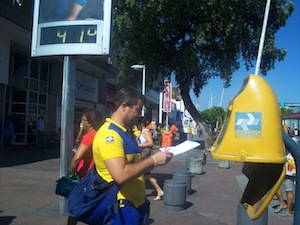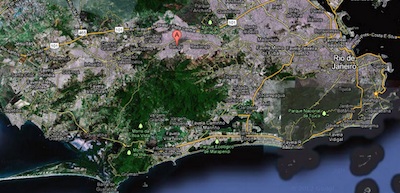For the original article in Portuguese by Viva Favela click here.
 The start of March marks the end of summer, disappointing those Rio locals (cariocas) who frequent the beaches, swimming pools and other sun traps. For many workers, the arrival of fall can be a relief. That is the case for mailman Cléber Saraiva, who works in downtown Bangu. During his shift, carrying a heavy weight and wearing a stifling uniform, he goes from street to street in two of Rio’s hottest neighborhoods. Cléber gets doubly tired working in the summer: “there are days when I get home and it feels like my head is exploding.”
The start of March marks the end of summer, disappointing those Rio locals (cariocas) who frequent the beaches, swimming pools and other sun traps. For many workers, the arrival of fall can be a relief. That is the case for mailman Cléber Saraiva, who works in downtown Bangu. During his shift, carrying a heavy weight and wearing a stifling uniform, he goes from street to street in two of Rio’s hottest neighborhoods. Cléber gets doubly tired working in the summer: “there are days when I get home and it feels like my head is exploding.”
The scolding heat in Bangu is not anything new for this summer. The neighborhood, in the western part of Rio, is known for its high temperatures. And for good reason: Bangu holds the record of 43.1°C (110°F), reached in 1984, the highest temperature ever registered by INMET (National Meteorological Institute or Brazil) in Rio. Tadeu Santos, who lives in the neighborhood and studies in the Ilha do Fundão, notices the difference in temperature between the two places: “Fundão, hot though it is, is always a little fresher than Bangu.”
Some geographical peculiarities make the neighborhood one of the hottest places in Rio de Janeiro. Its distance from the sea, which is a lot compared with many other parts of the city. Also, the area of Bangu is situated between two big landmasses: the Gericinó and Pedra Branca ranges. Pedra Branca, to the south, forms a giant wall that prevents the sea breeze from getting to the area. Being “confined” between these two ranges makes Bangu conducive to “heat islands.”
Claudison Rodrigues, the coordinator of the educational and scientific program at the Museum of the Environment, defines heat islands as “places where the temperature is higher than in other places due to less green space, lower air circulation and lots of roads.” This is a phenomenon that is unique to big cities – such as Rio – where the average temperature tends to be higher than in nearby rural regions.
According to a study on the thermal setting of Rio de Janeiro – written by Ana Maria Brandão and José Roberto Tarifa – the neighborhoods situated between the mountains “suffer from the influence of the katabatic warming of air, and they are subject to frequent periods of calm or light winds.” Katabatic is a type of wind that moves air from a high elevation down the slopes of the hills due to gravitational pull. The authors of the study go on to say that it is those topographic characteristics that make “the place famous for recording very high temperatures, often passing 40°C (104°F) in the summer.”
As with the above analysis, geographer Andrews José de Lucena – a researcher into the thermal patterns in western Rio – has identified a system of winds that are “frequently and exclusively in the Bangu valley area,” which he calls the Fohn effect. “Fohn or Chinook is a strong, dry and hot wind that develops downwind from a mountain range when stationery air is forced to pass over the mountains.” These two studies characterize the Bangu region as an area that sees a hot and dry wind form as a direct result of the mountain ranges that are nearby.
Sunny days, but bad sleep at night

The high temperatures have interfered with the quality of life of those who live in the area, making their daily lives more tiring and often affecting sleep. Tadeu, for example, notes that it is at bedtime that the heat is most uncomfortable. Without air conditioning at home, he takes a few measures to get some sleep: “to sleep in this weather I need an ice bath, at least two fans and as little clothing as possible.”
For this reason, it is at nighttime that the highest number of fans and air conditioning units are switched on full-blast. The hotter it is, the higher the demand on the electrical energy distribution system. It is likely that this demand was the reason behind two blackouts in Padre Miguel – a neighborhood next to Bangu – on February 28 and 29. Sheila Garcia, a local resident, describes what happened: “the lights went out around 10pm while I was watching TV. It was really hot during the day, and I couldn’t sleep until the power came back on.” According to Sheila, the electricity didn’t come back on until around two hours later, at midnight.
She also mentions the rise in electricity bills in the summer. Sheila compares how much she spent in November, a spring month, with January – the month with typically the highest average temperatures: “in November, my bill was R$64; in January it was R$83”. The difference in charges represents an increase of over 30%. For her, the explanation lies with the heat: “we have the fan on the entire night. That costs at the end of the month.”
Environmental Problems: unsustainable development and the deforestation of Pedra Branca

Besides the natural conditions of the neighborhood, the excess of heat in Bangu can be related to the human presence in the region that has intensified since the 1960s. Currently, Bangu is the second most populous neighborhood in Rio after its nearby relative, Campo Grande. According to data from 2010, from the Geo Portal run by Rio’s Pereira Passos Institute, there are currently 243,125 residents.
Lucena indicates that there was a more than 1°C (1.8°F) increase in average temperature in the 1980s and 1990s. The formation of heat islands is caused not only by the presence of roads and buildings but also by air pollution caused by greenhouse gases. Despite being a predominantly residential area, Bangu has high traffic levels throughout the main streets that run downtown.
The author also identified “significant losses in the vegetation coverage of Pedra Branca and Gericinó due to the expansion of occupancy of the hillsides” as one of the factors responsible for the rise in temperature. Amongst these environmental harms, the Pedra Branca State Park stands out. It is considered the largest forest reserve in an urban environment anywhere in the world and it contains the highest point in the city of Rio: the Pedra Branca Peak, at an elevation of 1,025 meters.
According to the Friends of Pedra Branca Park website, the process of favela occupation is also increasing throughout the area. The site also calls attention to the exploitation of the land caused by quarries, burnings and deforestation to make way for pastures and the expansion of crop harvesting. All of this has contributed to the decrease in green space in the Park which despite being protected by a rigorous environmental legislation is not adequately supervised or reforested by the public authorities.
Solutions: sprinklers or tree planting?

The elevated sprinklers along the main pedestrian drag in downtown Bangu, which have not worked for the last two years, started spraying again just a few days ago thanks to maintenance work being carried out. It was 2002 when the neighborhood got the cooling system that helps to reduce the heat felt by passersby. For a Bangu regular, Jane Barreto, the moisture helps to put up with the high temperatures: “when it is really hot and the area is full of people the sprinklers are the only form of relief.”
Despite its efficacy being proved in downtown Bangu, sprinklers are far from a solution for all the heat islands that form. A more efficient and long-term measure to reduce temperatures is the planting of trees and the preservation of green areas. According to Flávio Telles, the director of tree-planting at the Park and Garden Foundation, the surveys carried out by the government indicate that the P5 area (which includes Bangu, Campo Grande, Santa Cruz and others) shows a high demand for urban trees: “the areas where we do the most tree planting are the P3 (Rio’s North Zone) and P5, because they need it the most.”
The data and analyses of various specialists and the opinions of locals confirm what popular belief already knew: Bangu is hot. And the local geography is largely responsible for this. However, in these times of global warming, human intervention, including unrestrained growth, deforestation and pollution, can have a worsening effect on the situation. And it is a vicious circle: the hotter it is, the more energy is needed for air conditioning units. And if this energy is not generated in a clean way then there is another negative effect: the increase and spread of greenhouse gases. In this scenario, those who suffer the most are the poorest, who often do not have access to refrigeration or cooling systems. Global climactic changes are a reality – just look at global warming. Local changes are, too – just look at these heat islands. Bangu is hot, but it could get worse.
